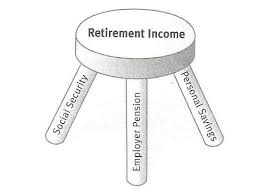Jeff Kempker, CEBS, CRC
Remember the good ole’ days when retirement planning for most Americans involved income being illustrated as a three-legged stool where the legs of the stool represented 1) income from a pension, 2) Social Security, and 3) personal savings? The thought was that as long as the stool has three legs it will be strong enough to support the person sitting on it. Take one of those legs away, and the stool becomes much less stable. Take two of the legs away and you end up on your back.
So why is it that every time I read about pension reform the proposed solution is always an all-or-none scenario where the pension will be shut down in favor of individual 401(k) accounts? This solution completely removes one leg of the stool (the pension) and reduces the retirement readiness for everyone affected. At LAGERS, we believe everyone who works hard and plays by the rules deserves a secure retirement and that this is best achieved by the three-legged stool approach.
When 401(k)s were first conceived in the late 1970’s, they were never intended to replace pensions, but to supplement the pension plan while allowing employees to defer taxable income. This was originally a great concept – one that furthered the notion of the three-legged stool. But over time, employers have eliminated their pensions and gone completely to the 401(k). The supplement has now become the main retirement income vehicle for many Americans. And it isn’t working. Even if their employer offers a 401(k), two-thirds of Americans aren’t using it to save for retirement.
One of the reasons Americans aren’t saving more is because investing as an individual is hard. Nearly seven of ten Americans cannot pass a basic financial literacy test. The average American worker is just not equipped to know how much to invest, what to invest in, when to re-allocate, and then how to turn their savings into a lifetime stream of income. Also, many Americans simply don’t have the means to go-it-alone in 401(k) accounts. The recommended retirement savings rate for an individual without a pension plan is north of 10% of income. For low-to-middle income workers, this is a daunting, if not impossible task. Pension funds, on the other hand, are invested by professionals and benefit from pooling so that one individual is not taking on all of the market risks.
Watch: Pension vs. 401(k), What’s the Difference?
One argument for moving away from pension plans in favor of 401(k)s is that the individual accounts cannot create unfunded liabilities. This couldn’t be further from the truth. Both pension plans and 401(k)s can create unfunded liabilities. An unfunded liability is established when liabilities exceed assets. In other words, the money you owe is more than the money you have on hand. The presence of an unfunded liability is not necessarily a problem so long as there is a steady, predictable, and disciplined approach to making the required contributions. Individual savers create unfunded liabilities when they fail to save enough for their retirement. When more and more individuals enter into retirement without adequate savings and huge personal unfunded liabilities their only option to sustain themselves in retirement will be to seek public assistance.
The bottom line is this: we need pensions and we need 401(k)s (and similar programs). We should not be seeking solutions that eliminate any one leg of the stool, but rather, to make those legs work together to provide a more stable base for all Americans.




